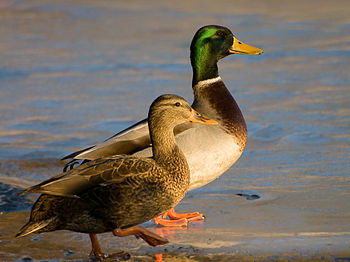 |
| Two Mallard ducks (Anas platyrhynchos). Male and female. (Photo credit: Wikipedia) |
During the warmer times of the year, it is common to find Mallard ducks relaxing on the waters of ponds and small lakes. They quickly catch on to the fact that people will come to these areas to feed them. Their natural diet consists of seeds, plants, and even small fish and frogs. They will also eat bread and popcorn when people come around with it. In fact, they will fight each other for it even though they aren’t hungry. They will consume all that is coming their way.
Even so, Mallard ducks are considered to be a wild type of duck. They are decedents of the various forms of domestic ducks out there though. They do seem to be comfortable around people. Those that have become accustomed to getting fed by them will even go up to people and take what they have to offer.
are considered to be a wild type of duck. They are decedents of the various forms of domestic ducks out there though. They do seem to be comfortable around people. Those that have become accustomed to getting fed by them will even go up to people and take what they have to offer.
Mallard ducks breed quite easily as long as their basic needs are being met. They will lay approximately 10 eggs at a time. The young ducks will hatch in about 60 days and the mother will take very good care of them. They know how to swim instinctively from the moment they hatch. She will teach them how to stay away from predators as well as how to search for food. They are very loving and caring mothers to their young babies.
Some individuals keep Mallard ducks as pets. They have a small pond on their property that they ducks live on. If they have well cared for them will return to the same location year after year. Some people put them in cages but they tend not to do well in such isolation. They will refuse to eat and many will die if you don’t allow them to have the freedom to explore.

No comments:
Post a Comment